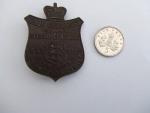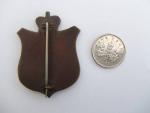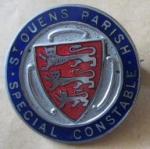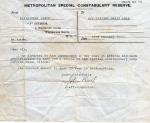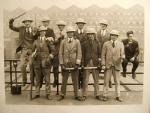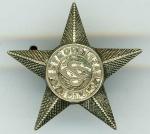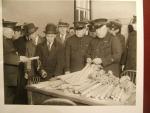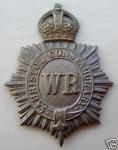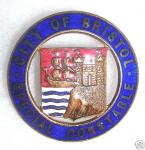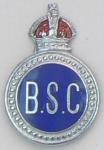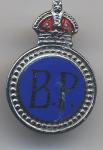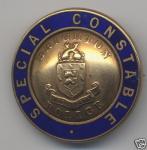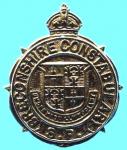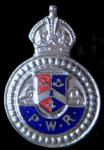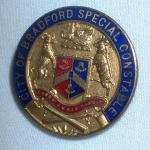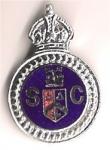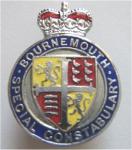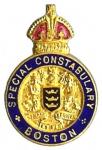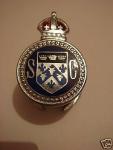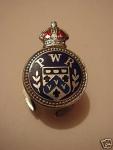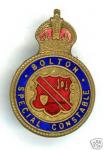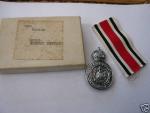
SCcollector
For Deletion-
Posts
583 -
Joined
-
Last visited
Content Type
Profiles
Forums
Blogs
Gallery
Events
Store
Everything posted by SCcollector
-
Recent Ebay activity :- This is another little cracker from the Channel Islands that was recently sold on Ebay for £336.96p. This one is from Vale on Guernsey and hails from the Great War. Again, I have never seen one of these before nor seen it listed. The amount realised, however, was quite staggering for a lapel badge.
-
Recent Ebay activity :- This badge was recently sold for £75 on Ebay. From the description given by the seller, it was a lapel badge issued in 1939 shortly before the outbreak of war to the parishioners of the village of St Ouens who volunteered as Special Constables to supplement the Police Honorifique de St Ouen. The badge ceased to be worn after the german invasion of 1940. I have never seen an example before and I cannot recall seeing it listed anywhere. Given the size of the settlement and the circumstances, this must be extremely rare. Taking that into consideration it probably brought a very resonable selling price.
-
This is a very interesting letter from Northampton Special Constabulary from WW11. A few things spring to mind. Firstly, that a mobile section of the spcial constabualry was operating in the town. Secondly, that the special constabulary appeared to have some administrative responsibility for the Police Auxilliary Messenger Service. And lastly, that it is a reminder of the sterling service rendered by the youngsters serving with the PAMS. I wonder what happened to this young man during his military service? Kevin
-
Here is another interesting document from the same era. A thank you letter 'Major Castle' of Ipswich from the Suffolk Emergency Police Reserves for his services during the General Strike. Suffolk had the tradition of calling their special constabulary the 'police reserve'. One wonders what role the good major played in the crisis. Kevin img152.pdf
-
Hi, This is another interesting picture depicting the Barclay, Perkins & Co. Brewery Special Constabulary members from the General Strike. The Anchor Brewery was formed in 1616 and was taken over by Barclay, Perkins & Co. in 1781. It was the largest brewery in the world and was reported to be brewing some 330,000 barrels per year in 1815. A fire in 1832 destroyed many buildings which were rebuilt. The company merged with Courage in 1955 to become Courage, Barclay & Co. The brewery was finally demolished in 1981. I have been unable to find out very much about the SCs from the brewery and how they fitted into the general picture during the 1926 strike. A few of the ranks appear to be old soldiers. Another very interesting photograph.
-
Hello Nick, Absolutely! Out of interest, I remember the exchange of opinions on the Special Constabulary Forum on the arming of special Constables which took place a few months ago. I did a little reading and came across the decision by the Home Office to encourage the arming of special constables and militias etc.. during the chartist disturbances. I also found a reference to a special constable firing on a rioter and killing him (shot to the face). He was subsequently tried for murder and acquitted. I seem to remember that the incident took place in the north of england. Unfortunately I can't find my notes but will contiunue to search. I also found references to the attempted rising by Chartists at Bradford . Two groups of Special Constables from neighbouring villages, when out on night patrol, mistook each other for insurgents and engaged in an exchange of fire. Luckily, nobody was injured. Another exanple of our violent past that the society of today appears to ignore or, worse, attempts to sanitise.
-
Hi again, Success! Here is the photograph of the Oxford Students (periodical unknown) I don't really know what to say actually. I can only presume that they caused absolute havoc unless they were kept on a very short lead. I have seen no other examples of steel helmets being issued to SCs during the General Strike. The setting appears to be industrial and the little character sat on the extreme right is odd. Altogether a little gem of a picture. I picked both pictures up via Ebay from a gentleman in Portugal (not ex pat).
-
Hello Mervyn, The star on the officers sleeve is, I think, the Metropolitan Police Special Constabulary Long Service Star issued in the Great War. A photograph is attached. What do you think? It looks about the right size. The truncheons certainly seem to be crudely turned and may well have been a rush job. Perhaps it was the same with arm bands which all look new. I obtained another photograph at the same time which is apparently of a group of Oxford Students sworn in as SCs in 1926 who also have very crude truncheons and , interestingly, WW1 pattern steel helmets. They also have arm bands which are worn just above the wrist on the left hand sleeve. Most photographs of Specials appear to depict the arm band being worn high on the sleeve. It is also interesting as they appear to be a group of complete idiots. The file is too big to download here but I wiil have another go. If all else fails I will email you a copy as it is very interesting. Kind regards, Kevin
-
The third article relating to the Bradford Strike Riots as it appeared in The Times appears below. The outcome of the case brought by Mr Saunders is of note, also the use of only 32 officers against the Manchester road mob was more than suifficent to the restoration of order. An interesting look at a time long passed buit which bears striking similarities with more recent events in this country. Here is the final article :- Bradford Riots. The Times. Thursday April 16. 1891. At the Bradford Borough Police-court, yesterday morning, the test case brought by Councillor Saunders, of Rotherham, was heard by the Stipendary. Mr Waugh prosecuted, and Mr T.R.D. Wright defended the police officers against whom summons for assault had been granted. The assault complained of was the arrest of Councillor Saunders. Mr Waugh contended that the public had a right to use the place known as Dockers-square for the holding of public meetings. He also contended that, if the ground were private, the police had no right to arrest Mr Saunder, but were only entitled to ake his name and address. For the defence, Mr Wright produced a notice which had, up to two or three years ago, been posted in the square, stating that the Corporation reserved all rights in connexion (sic) with the piece of ground. As to the alleged illegal arrest of Mr Saunders, he called a constable to prove that the gentleman had requested the policemen to lock him up, as he desired to have a trst case. The proceeding occupied all day, and, after a lengthened consideration of the arguments adduced and the facts narrated, the Stipendary gave the decision of the Bench as follows :- "We do not think that the right of public meetings is involved in this case. We do not think it necessary to decide whether the piece of ground referred to is, or is not a highway. It is undoubtedly a place of public resort. We find that the complainant was causing an obstruction, not only upon the plot of ground, but also on the adjacent highways and footpatths. The defendants were acting in the execution of their duty in requiring the defendant to move on in order to remove the obstruction. We find that the complainant obstructed the defendants in the execution of their duty as constables, and they were justified in arresting him. We therefore dismiss the summons." Several persons were fined at the Borough Court yesterday for assaults on the police and stone-throwing. During the day all was quiet in the centre of the town, and the police, instead of allowing people to assemble in crowds, kept them moving about. The Mayor issued a warning to all respectable people to keep away from the scene of the distrubances on pain of being treated as a riotous persons. There was yesterday no alteration in the position of the strike at Manningham Mills. The people of the town were for the most part, says a letter of despatch,, peacably disposed last night, and only one arrerst was made, that of a man who refused to move on when requested. Shortly after 9 o'clock there was some disturbance in Manchester-road, occasioned by the throwing of stones and glass bottles by abot 200 roughs. A body of 32 constables, however, speedily dispersed them, and soon the neighbourhood was quiet again. The special constables were held in readiness, and also 200 of the Durham Regiment, but they were not called out, nor were the whole of the police sent into the street. No further disturbance is expected. (End of Article)
-
Bradford Strike Riots. Below are details of the second article appearing the The Times. I am absolutely fascinated by the arrest of the special constable for stone throwing. Unfortunately, the outcome of his case was not reported. Here is the second article :- BRADFORD RIOTS The Times. Wednesday. April 15. 1891. The Strike Riots at Bradford. At 12 o'clock o Monday night all was quiet in the centre of the town of Bradford, and when the crowd had dispersed the military were withdrawn to the barracks. Throughout the whole of yesterday large numbers of people loitered about Dockers-square, but there were no further attempts to hold meetings, and consequently, up to 6 o'clock there was no disturbance. Arrangements were made, however, for calling out the special constables to assist in keeping order in necessary. At the police-court yesterday morning a number of persons were charged with assaulting the police, penalties ranging from 5/- to £5 being imposed on them. The directors have definitely declined to submit the disopute to arbitration on the ground that the adoption of such course would be all together impractical. A later telegram states that the trouble last night was not so bad as on Monday evening, but, for all that, the town was in a state of great excitement, and about 200 men and officers of the Durham Regiment and a strong body of police wewre necessary. The serious part of the business commenced about 8 o'clock, at which time a great crowd gathered around the Town Hall. The policemen were called outside to clear a number of youths who were getting a supply of stones on an open space of ground near to the Town-hall. When darkness came on the gas in the street lamps was turned out, and as stone-throwing was commenced the police and military filed out into the street. No serious resistance was offered, but there was a heavy discharge of stones at the men. Several of the soldiers and policemen sustained injuries, and Police constable Lee, one of the mounted officers, was struck on the nose with a stone. A great number of windows were broken during the night, but, on the whole, matters were from being so serious as on the previous evening, and the injuries sustained were not so bad. Of the public nearly a dozen persons were taken to the Town-hall and had their injuries attended to by Dr Sam Lodge. During the evening about half-a-dozen persons were arrested for stone throwing, amongst them one of the special constables who had been called out for duty. Two of the ordinary policemen stated that they saw him not only neglecting his duty by watching men throw stones, but also take offensive action and throw stones himself. He, it is said, had a missile in his hand when arrested. He was not kept in custody, but it is understood he will be summoned. By 9.30 the disorder was practically at an end. At 10 o'clock the military were withdrawn. Afterwards the special constables and extra policemen were called in. No attempts were made to hold meetings during the night. By 10.30 all was quiet again. (End of Article)
-
I recently acquired three original copes of The Times newspaper dated 14, 15 & 16 April 1891 as part of my ongoing interests which include the history of the Bradford Police and of the early history of Special Constables. These particular copies were of interest to me as they contain details of Strike Riots at Bradford. I have copied the details of the first article below for the interest of members. Several things come to mind. Bradford had a long history of violent disorder and would be recognised at the time as a potential flash point for trouble. The insertion into what was essentially a local industrial dispute of elements from outside the town with different agendas is evident; the reported comments at the meeting in Dockers Square being unwise to say the very least and quite possibly an attempt to incite violence and disorder. The tactics of the gentleman from Rotherham (what he was doing in Bradford is open to debate) to use the legal system to establish wider precedents via the pursuit of the officers who arrested him is worthy of note. The scale of the disorder and the violence used is indicative of the times, as is the use of military support. The following days saw a continuation of the disorder and the use of large numbers of special constables to assist the police in restoring order. Here is the first installment :- BRADFORD RIOTS THE TIMES. TUESDAY APRIL 14. 1891. Strike Riots at Bradford. After about 10.30 on Sunday night all was quiet in Bradford in connexion (sic) with the Manningham Mills strike. The people went to their homes, and the police were sent on their ordinary beeats. Councillor Saunders, of Rotherham, who was arrested for addressing a meeting in the Dockers-square, after the authorities had refused to grant permission, declined to leave the Town Hall after his name and address had been taken. He insisted on being locked up and brought before the justices, in order that the right of the public to hold meetings in the square might be contested. The police declined to gratify him on this point, and accordingly he remained in the charge office all through the night. Even yesterday morning he did not leave the office until the white-washers commenced operations therein, and then he ramained in the area of the Town Hall untill 11 o'clock, when the court opened. Meanwhile, he and his friends had obtained legal advice, and, after the stipendary magistrate (Mr Skidmore) took his seat, Mr Waugh, barrister, applied for a summons for assault on Mr Saunders. He detailed the incidents leading up to the arrest of that gentleman, and said that until the action of the two constables who took Mr Saunders into custody was justified, there was an assault in law. He therefore applied for summonses for assault against the two officers, and that would raise the question of the right of the public to hold meetings in the Dock-square, and whether the officers were acting within the scope of their duty and according to the law in doing what they did. The stipendary magistrate granted the summonses, and made them returnable to-morrow. All was quiet yesterday until about 2.30 in the afternoon, when the square, in the absence of the police, was again taken possession of by some persons calling themselves Social Democrats, from Leeds. A large crowd soon assembled, and the speakers defended the right of the public to hold meetings in the disputed sqaure. The people were requested to remember what the Socialists had done in Trafalgar Square, London, against troops and police; but on the appearance of the chief constable, Mr Withers, and a small body of policemen, the meeting was brought to an end and the square cleared. Those assembled were evidently in bad humour, however, and lingered in considerable numbers about the place. They declined to attend a meeting in another part of the town, and repeatdly called on the speakers to again mount a platform constructed of a couple of boxes. The Socialists did not attempt to do so during the afternoon, but the behaviour of the crowd was such that other arrests had to be made. Ther promoters of this meeting were in no way connected with the strike. The directors of Messrs. Lister and Co., had a meeting yesterday morning, to consider the proposal of arbitrating made by the hands. Up to last night the results of their deliberations had not been made public; but it was understood that the directors would decline to submit the dispute to arbitration. A later telegram states that, as feared, the disturbances which commenced yesterday afternoon became serious during the evening, so much so that throughout the whole of the night the town was one scene of disorder and uproar. The military had to be called out, and the Riot Act read by the Mayor, Mr E. W. Hammond. The beginning was an attack on a constable, about 7 o'clock, after which the mob assailed half-a-dozen officers. Stone throwing followed this, and the the large plate glass windows of an adjacent clothier's shop were broken. Repeated attempts were made to clear the space around the Town Hall, but the people came up again as fast as the police retired. At five minutes past 9 o'clock 106 rank and file of the Durham Light Infantry, under command of Major Woodhead, with Captain Robb and Lieutenant Platt, arrived at the Town Hall from Bradford Moor Barracks, each having 40 rounds of ball cartridge. They were at once quartered in the spacious area, and the authorities set about preparing for finally clearing the square and the adjoining streets. The Mayor, Alderman E. W. Hammond, attended by the chief constable and several members of the council, crossed the surging crowds at the New Inn, at Thornton-road corner, and there he read the Riot Act. Soon after this the military paraded the streets, and charged the people in various directions. The mob soon got used to this, and grew bolder. Eventually a baton charge by the police was was found necessary. Many slight injuries were inflicted, but only one man was so seriously hurt as to necessitate his removal to the Town Hall, where he was medically attended. His name was Maloney. He sustained an ugly wound on the left side of his head, and bled profusely. The chief constable and other officers sustained injuries about the head and body. Detective Martindale was knocked off his horse with a brick, and Superintendent Scott's horse was stabbed in the breast, and had to be taken to a vetinery surgeon. Open knives were thrown at the police at times. Up to midnight the streets were crowded, and the military were making charges with fixed bayonets, the the stone-throwing then ceased. (End of Article)
-
Ebay auctions... Bristol. War Reserve. HP. KC. Sold for £26.08. on 22 September 2008. SC Lapel Badge. Voided. Sold for £26.57 on 25 October 2009. SC Lapel Badge. Solid. Sold for £21.99. 30 September 2008. Sold for £33. on 1 February 2009. Sold for £31. on 22 February 2009. Sold for £9.50. on 30 March 2009. (damaged enamel) SC 'BSC' Lapel Badge. KC. Sold for £15.50. on 30 August 2009.
-
Ebay auctions... Brighton. SC Lapel Badge. Chrome & Enamel. KC. Sold for £17.50. on 19 November 2008. Sold for £16.75. on 25 January 2009. Sold for £15. on 12 December 2009. Lapel Badge. Brass & Enamel. Sold for £12. on 16 February 2009. Sold for £19.05. on 9 March 2009. Photograph. Brighton SC 'B' Division. WW11. Sold for £8.50. on 28 April 2009.
-
Ebay auctions... Bradford City. PWR. Lapel Badge. KC. Sold for £16. on 14 November 2008. Sold for £10. on 2 February 2009. Lapel Badge. Brass & Enamel. Sold for £41. on 12 October 2008. SC Lapel Badge. Chrome & Enamel. KC. (lesson in persisting and winning through in the end!). Did Not Sell (starting price £15) on 7 September 2009. Did Not Sell (starting price £15) on 20 September 2009. Did Not Sell (starting price £4.99) on 28 October 2009. (no rear fixing) Did Not Sell (starting price £4.99) on 22 November 2009. ( " " ) Did Not Sell (starting price £15) on 12 December 2009. Did Not Sell (starting price £15) on 24 January 2010. Sold for £15. on 26 February 2010.
-
Ebay auctions... Bolton SC. Lapel Badge. KC. Sold for £29.55. on 11 January 2009. Cap Badge. KC. Did Not Sell (starting price £5.99) on 20 January 2009. Sold for £7.29. on 7 April 2009. (included NFS Cap Badge) Did Not Sell (starting price £9) on 16 June 2009. Did Not Sell (starting price £10) on 27 January 2010 Nice Group. Cap Badge and LS Medal to Ernest Sefton Sold for £18.50. on 1 March 2010

